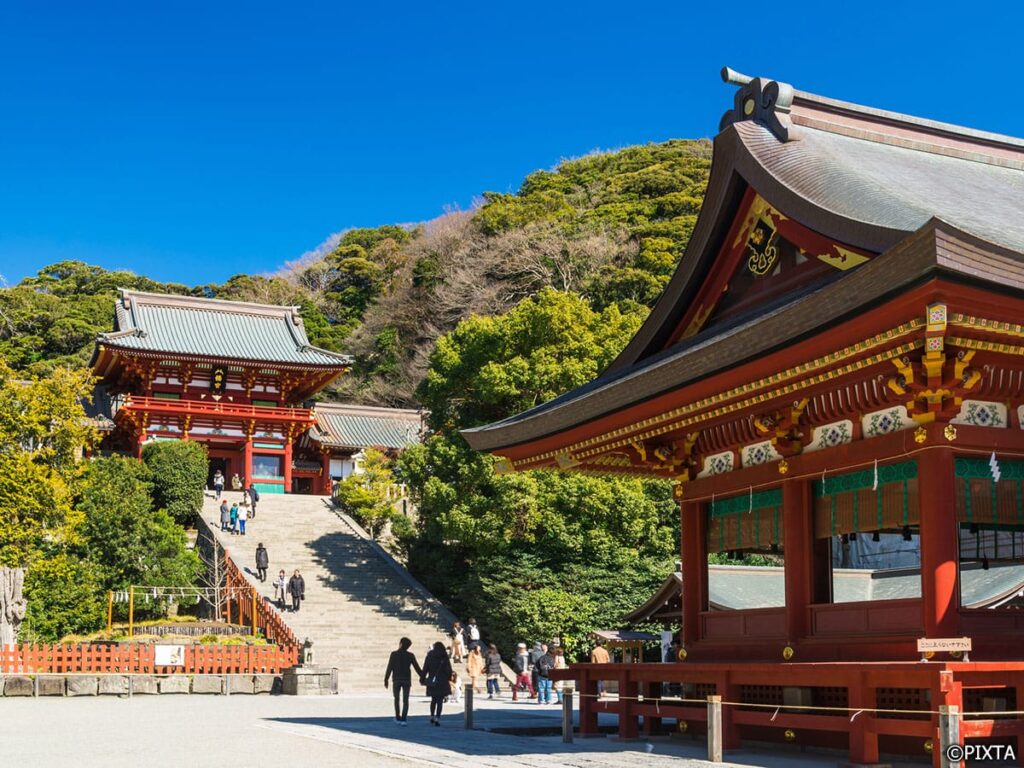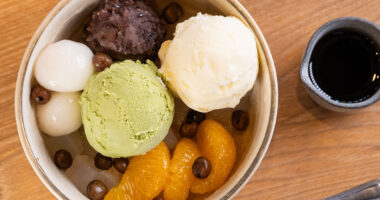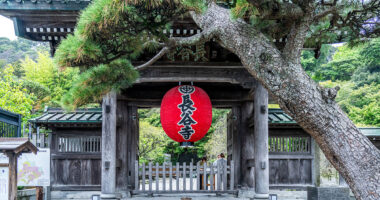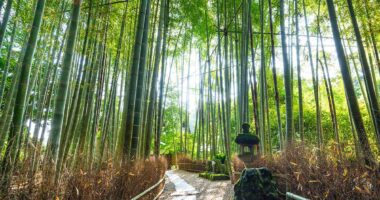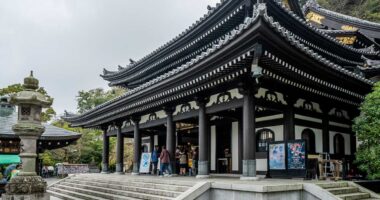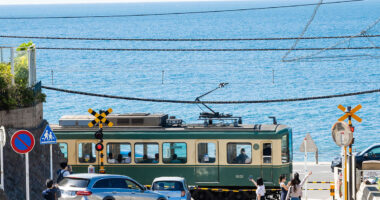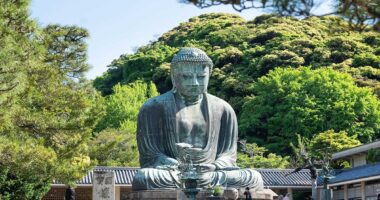Situated along the coast just south of Tokyo, the ancient city of 鎌倉 Kamakura was once the political center of Japan during the Kamakura Shogunate, from the late 12th to the early 14th century. Today, this captivating city offers an intriguing blend of history, coastal beauty, and a relaxed atmosphere, making it an ideal destination for travelers seeking a break from the urban hustle. With its impressive collection of temples and shrines amid verdant hills, quaint streets lined with traditional shops and cozy cafes, and pristine beaches with picturesque views of Sagami Bay, Kamakura, along with the nearby island of 江の島 Enoshima, provides a unique glimpse into Japan’s cultural and natural heritage.
Access
Kamakura is easily accessible via the JR Yokosuka Line and Enoshima Electric Railway (Enoden). The nearest station is Kamakura Station (JK45/YK65), which is approximately 55 minutes from Tokyo Station. From Kamakura Station, many of the city’s main attractions are within walking distance or a short ride on the scenic 江ノ電 Enoden line. Keep in mind that exploring some parts of Kamakura and almost all of Enoshima may involve a significant amount of walking and some slopes, so plan your trip accordingly.
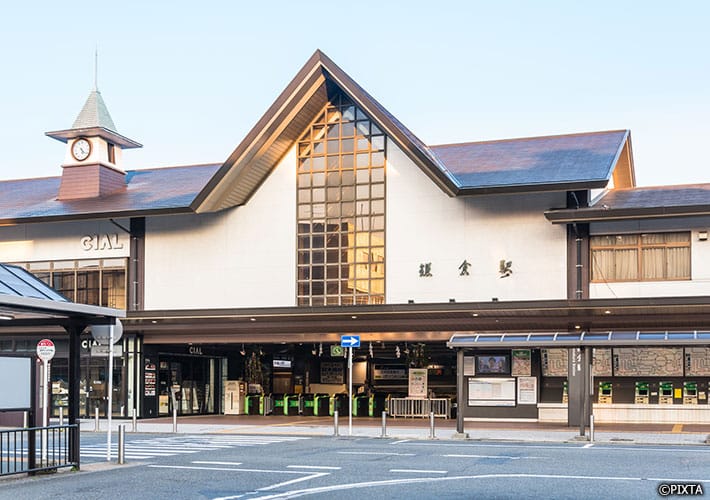
JR Kamakura Station.
Food and Drink
Kamakura is known for a variety of local culinary offerings, making it an enjoyable destination for foodies.
しらす丼 Shirasu-don: Kamakura’s coastal location allows for an abundance of fresh seafood, with しらす shirasu (tiny whitebait fish) being a local specialty. Shirasu-don, a bowl of rice topped with freshly caught shirasu, is a must-try dish for seafood lovers. It is particularly famous in Enoshima.
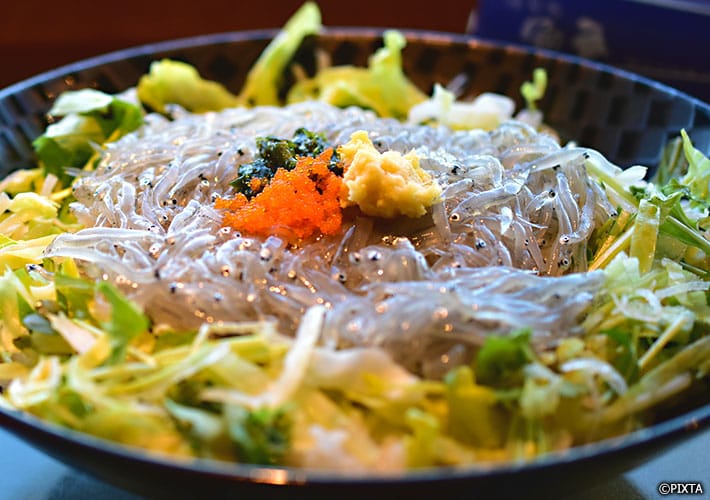
Shirasu-don is particularly famous in Enoshima.
Stylish Cafes: Kamakura is home to a variety of charming cafes, offering a nice opportunity to relax and indulge in delicious coffee, tea, and desserts. Many of these cafes are housed in traditional Japanese buildings, while others offer gorgeous vistas along the beach, providing an inviting atmosphere for visitors to unwind.
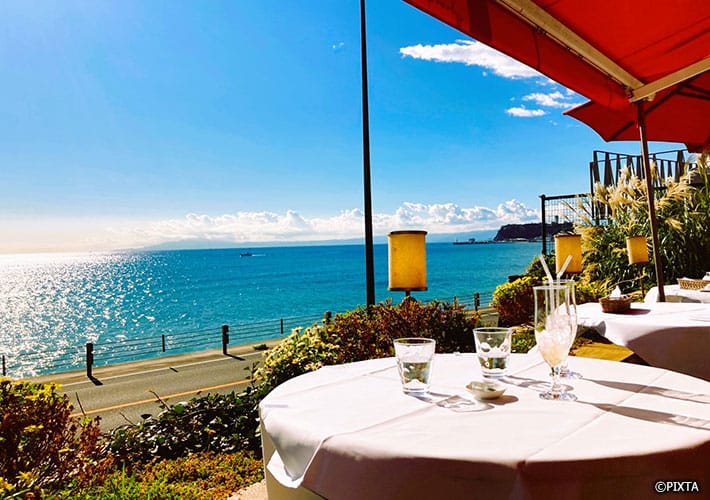
A cafe with a view of 七里ガ浜 Sichirigahama Beach in Kamakura.
Shopping
小町通り komachi-dōri Komachi Street: This appealing shopping street, just a short walk from Kamakura Station and stretching all the way to 鶴岡八幡宮 Tsurugaoka Hachimangu Shrine, offers a diverse mix of traditional crafts, souvenirs, and local food. You may want to avoid walking while eating, however, since black kites (falcons) may snatch it and possibly injure you with their beaks and talons in the process.
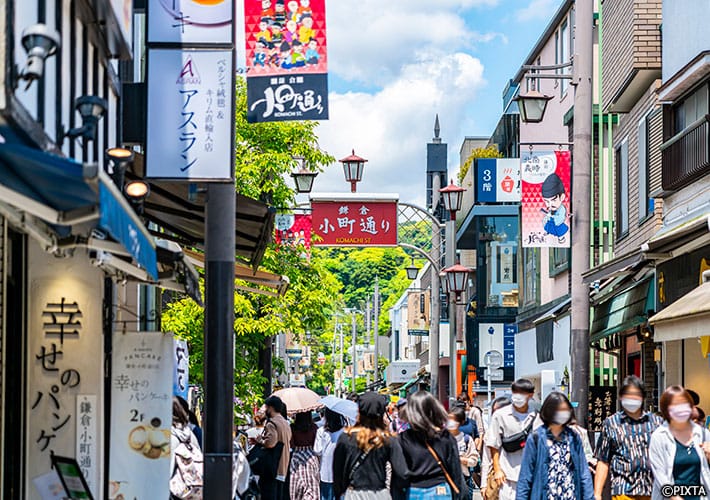
Shopping along Komachi Street in Kamakura.
Sweets: Kamakura is well-known for its variety of sweets, both traditional Japanese wagashi and Western-style confections. Visitors can find numerous shops offering delectable treats, which are popular choices for gift-giving. A few of these are not only famous as Kamakura souvenirs but have become popular nationwide.
鎌倉彫 Kamakurabori: You can discover the art of Kamakurabori, a traditional woodcarving technique born in Kamakura that creates intricate designs on wooden items such as trays, bowls, and ornaments. These refined crafts make for memorable souvenirs.
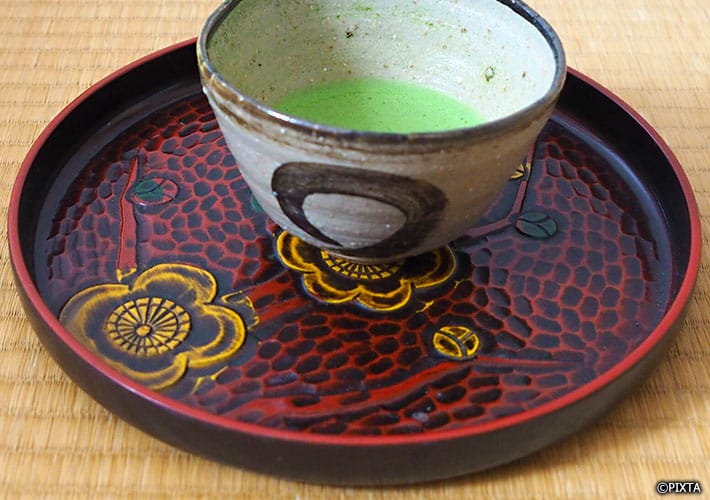
Matcha served on a kamakurabori tray.
Sightseeing and Activities
Kamakura’s charm as a perennially popular tourist destination lies in its remarkable range of sightseeing spots afforded by its exceptional collection of temples and shrines. Here are some of the most notable ones:
The Great Buddha: Kamakura’s most iconic sight is the Great Buddha (大仏 daibutsu), a massive bronze statue of Amida Buddha, located at 高徳院 Kōtoku-in Temple. This impressive statue, towering at over 13 meters (42 feet) in height, is a testament to the city’s rich historical and spiritual legacy.
Tsurugaoka Hachimangū Shrine: The city’s most important Shinto shrine, Tsurugaoka Hachimangu, is set amidst picturesque grounds, featuring tranquil ponds and lush greenery. It is a popular spot for traditional Japanese weddings and offers stunning views of the city.
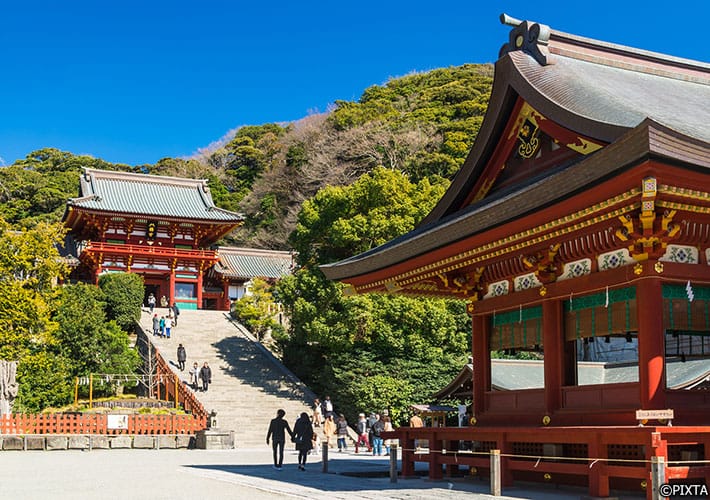
Tsurugaoka Hachimangu Shrine is a Kamakura landmark worth visiting.
長谷寺 Hasedera Temple: Famous for its magnificent hillside garden and panoramic views of Sagami Bay, Hasedera Temple is a must-visit destination for nature lovers. In late spring, the temple’s grounds are adorned with vibrant hydrangea flowers, creating a colorful spectacle.
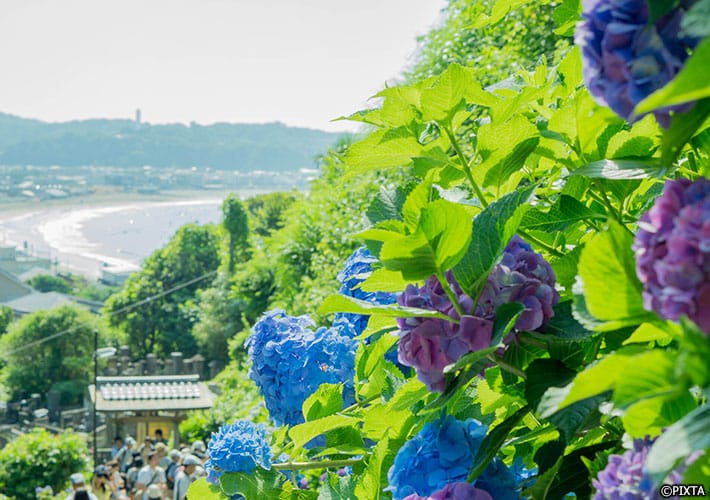
A view of Sagami Bay and hydrangeas in bloom from the hillside gardens of Hasedera Temple.
報国寺 Hōkokuji Temple: Often referred to as the “Bamboo Temple,” Hokokuji is renowned for its enchanting bamboo grove. Visitors can wander through the serene forest, appreciating the gentle rustle of the bamboo leaves and enjoying a moment of tranquility amidst nature.
明月院 Meigetsu-in: Known as the “Hydrangea Temple,” Meigetsu-in boasts a beautiful garden that comes alive with brilliant blue hydrangea blooms during the rainy season. The temple’s circular window, framing the garden, offers a captivating view and a serene atmosphere for contemplation.
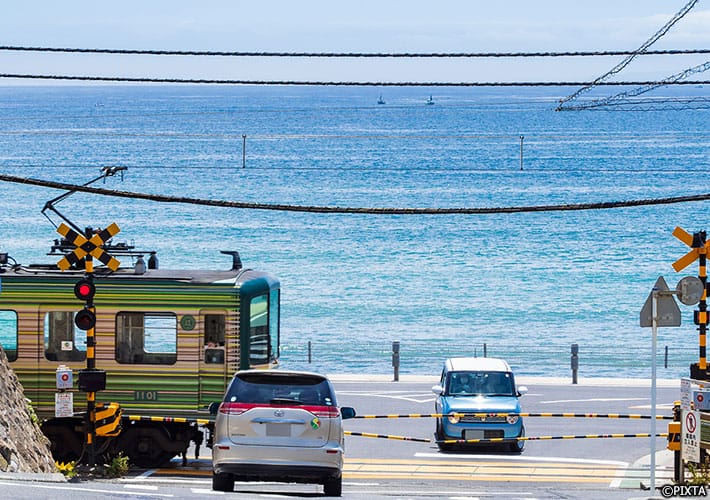
A famous and picturesque anime pilgrimage spot in Kamakura.
Manga and Anime Pilgrimage Spots: Fans of Japanese pop culture will delight in exploring Kamakura’s numerous manga and anime pilgrimage spots. Most famously, the crossing at 鎌倉高校前駅 Kamakurakōkō-Mae Station, a 20-minute ride away from Kamakura Station on the scenic Enoden train, appears not only in the opening sequence of the internationally-famous basketball manga Slam Dunk‘s anime adaptation (1993-1996) but also appears several times in the musical slice-of-life anime Tari Tari (2012).
江の島 Enoshima: The nearby island of Enoshima is a popular destination for visitors exploring the Kamakura area. Connected to the mainland by a bridge, Enoshima offers a range of attractions, including the Enoshima Shrine, the Samuel Cocking Garden, and the Enoshima Sea Candle observation tower. With beautiful coastal views and a variety of shops and restaurants, Enoshima provides a delightful experience for visitors. You’ll also find street vendors selling various types of sweets and savory snacks. However, if you buy something, eat it before you cross the bridge leading back to the mainland. Even moreso than Komachi Street, hungry falcons are usually on the lookout here.
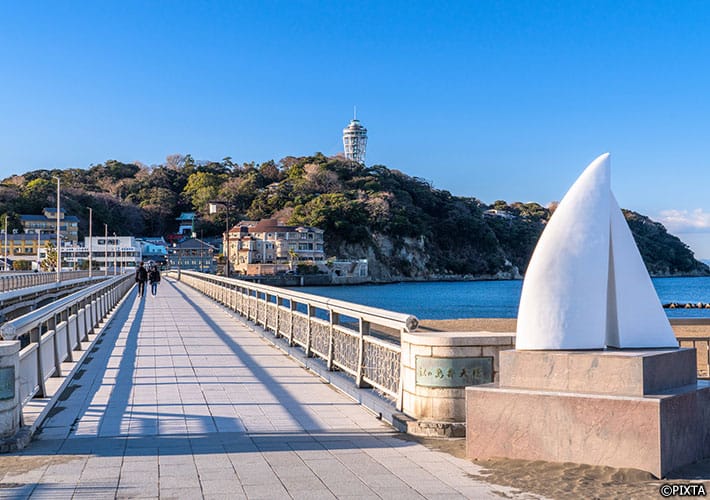
The bridge leading to the picturesque island of Enoshima.
Beaches: Kamakura’s coastline offers a variety of pristine beaches, such as Sichirigahama, 由比ヶ浜 Yuigahama and 材木座 Zaimokuza, perfect for sunbathing, swimming, and surfing. With their golden sands and stunning views, these beaches provide a refreshing break from the city’s historical sites.

Strolling along the beach at Kamakura.
In conclusion, Kamakura’s rich history, beautiful temples and shrines, picturesque landscapes, and enjoyable culinary scene make it a must-visit destination for anyone traveling to Japan. With its captivating blend of old and new, this coastal city, along with the nearby Enoshima island, promises an unforgettable experience showcasing the best of Japanese culture and nature.
